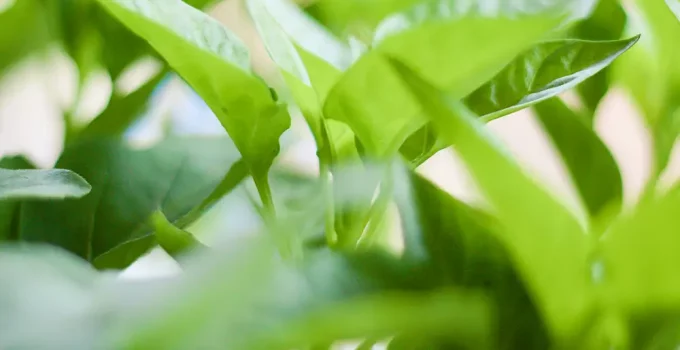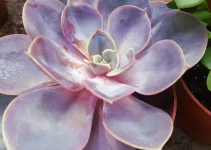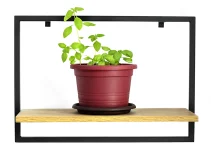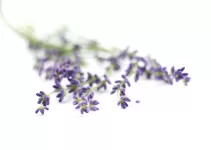Whether you want to know how to grow peppers in pots indoors or outdoors, this guide will give you all the answers.
Well, those who already have experience with growing tomatoes in containers, will have a really easy time with growing peppers in pots. These two fruits are quite similar when it comes to growing conditions and in regards to seed propagation.
Table of Contents
How to Grow Peppers in Pots Indoors

Those who live in apartments can also learn how to grow peppers in pots. And the same goes for those who want to grow vegetables even during the cold months.
We’re mostly accustomed to growing herbs indoors in containers but that practice can be extended to growing peppers, tomatoes, strawberries, baby spinach and leafy greens, avocados, and even pineapple plants.
For now, let’s focus on learning how to grow peppers in pots indoors and all that entails.
1. Choosing the best pots for pepper plants
This is the first major decision you must make. And it all depends on how much space you have and how many pepper plants you actually want to grow.
You can buy planters or indoor raised garden beds or grow bags but you can just as well use whatever containers you have: 5-gallon buckets, old storage plastic containers, etc.
Just remember about drainage holes and to put something underneath the container to catch excess water.
Pot size: 12-inch or 14-inch pots are the best
This is a broad subject because you can use 8 inch, 10 inch, 12 inch or 14 inch pot. Plant one pepper plant per container, that’s the best.
You can use regular pots or you can go for self-watering pots.
In terms of size, I definitely recommend the 12-inch or 14-inch ones. The more soil they can fit in the better. However, chili plants can grow in 8-inch containers, too.
An at least 2 gallon pot is the right size for pepper plants But if you can buy a bigger pot than the 2 gallon size, that’s awesome.
I would say that, generally, pepper plants need 3-5 gallons, although you could manage with 2 gallons, too.
Indoor raised garden bed
Or you choose to grow in raised garden beds that can be used indoors. These are pretty big and, depending on their size, you can grow at least 2-4 plants in the same container. But they’re also quite pricey.
Moreover, even a smaller indoor raised garden bed will require at least 10 gallons of soil. Some will need 20 gallons or more.
That is another cost that you must take into consideration.
Grow bags
Last but not least, you can grow pepper plants and all sorts of other plants in grow bags.
There are a couple of very important advantages that grow bags offer:
- they’re big (5-gallon or 7-gallon or even 10-gallon) – the 10 gallon ones are really good if you want to grow things like lemon trees indoors or potato plants but for pepper plants you can go with the 5 gallon grow bags
- they’re cheap – you can probably buy 5 grow bags for the price of a 12-inch planter
If you decide to buy grow bags, you will need a saucer/tray to catch the excess water, just like we do for regular planters with drainage holes.
2. Best soil for growing peppers in pots
If you’re growing in pots or containers, you need to use a rich potting soil. It’s also important to have well-draining soil.
Don’t go for garden soil. The major thing about potting soil is that it offers the much needed aeration for the roots, while garden soil can become compact.
You can make your own soil or you can buy potting soil. However, if you have large containers, it might be cheaper to make your own.
You can make your own potting soil mix from composted bark, coconut coir, peat moss, perlite, and pumice. Add all these components in equal measures. Worm castings can constitute another wonderful addition.
3. Pepper varieties
There are 2 main varieties that most of us focus on when it comes to learning how to grow peppers in pots: bell peppers and chilies. It’s a matter of whether we want non-hot peppers or the hot ones.
The methods are the same for both these categories. Thus, whatever variety you end up choosing, the same instructions apply.
However, when growing peppers in pots or containers or even grow bags, there’s one important question we must ask ourselves: how big is the pepper plant going to grow?
Usually, pepper plants are compact enough that they’re quite suitable for growing in pots. Otherwise, I wouldn’t be writing this guide.
I recommend red bell peppers if you want to grow one of the sweetest varieties. In regard to chilies, I love jalapeños.
Pepper varieties to grow in pots/containers
I’ve already say that red bell pepper are jalapeños are two of my favorite pepper varieties to grow in pots. But there are a lot more varieties that you can grow in containers, both indoors and outdoors.
- bell peppers – even if they’re not the easiest variety to grow in containers indoors but it can be done with a bit of pruning, bell pepper plants are easier to grow in pots outdoors, they’re delicious when eaten raw and perfect for cooking a wide variety of dishes, red is my favorite bell pepper variety
- sweet red kapia – a variety related to bell peppers, amazingly sweet and delicious, with long and slender fruits that mature from green to red, when they’re a lipstick red they’re ready for harvest
- sweet banana pepper – one of the best sweet pepper varieties that can be used for cooking, in salads, and for pickling
- jalapeño – one of the most famous chili varieties, it’s delicious, mildly spicy and one single plant can produce about 30-40 jalapeño pepper pods
- poblano – a mild to medium-heat pepper that is milder than jalapeño and a lot meatier with an earthy, slightly smoky flavor, they’re absolutely delicious
- shishito – a very mild variety, the plants are pretty compact, they’re an awesome pepper variety if you like your chilis very mild, they’re perfect for quick frying, grilling, or tempura
4. Pepper seeds germination
Once you’ve decided which seeds you want to propagate, it’s time to get down to business.
You don’t have to spend your money on special propagation trays unless you want to.
Firstly, soak the seeds in warm water for 2 to 8 hours but don’t exceed 12 hours. As this YouTube video demonstrates, seeds soaked for no more than 12 hours, will germinate more quickly, by as much as 2-4 days.
Use a seed tray or an egg cartoon or whatever plastic container you have around.
Use loose draining soil for germination and make sure that it’s wet with water. You can also buy seed starter potting mix.
Poke a 1/4 inch hole and add one seed per hole. Cover the tray, you can even use plastic wrap if you don’t have a germination tray with a dome.
Keep the seeds in a warm location, at least 80 degrees Fahrenheit (26-27 degrees C). You can use a seedling heat mat.
Maintain the soil moist. Don’t let it dry out.
If you have grow lights, you can let them on for 14-16 hours per day when the seedlings just start to break the surface. That’s also the time when you remove the dome.
The germination usually takes 8 to 12 days.
You can also use fertilizer once the seedlings have 2 sets of true leaves. Check out my cotyledon vs true leaf article to discover what true leaves are.
After 2-3 weeks from sowing the seeds, seedlings can be transferred from their small propagation cubes to larger pots, like 4 inch pots per seedling or a bigger pot for multiple seedlings.
After another 2-3 weeks, you can transplant the seedlings into their final pots/containers.
In conclusion, you need about 6 weeks from when you first sowed the seeds until they’re ready for transplantation.
If you need a complete visual guide, check out this video.
5. Hot temperatures
Pepper plants should be kept at temperatures between 70-80 degrees Fahrenheit (21-27 degrees C).
6. Watering schedule
When you water, the important thing is that you need to soak the soil completely. Water should come out of the drainage holes and then you know that you can stop.
How often you water depends on how soon the surface of the soil dries. That’s the best way to know.
Allow the top of the soil to just barely become dry. That’s how you tell when it’s time to soak the soil completely.
7. Lighting
If we’re talking about natural light, peppers thrive in full sun. That can be fairly easy to guarantee if you’re growing outdoors.
Indoors, the easiest way is to provide them with 14 hours under grow lights. They also need those 10 hours of darkness so don’t forget to switch your lights off.
The lights should be kept about 3 inches from their top.
When learning about how to grow peppers in pots indoors, figuring out how the plants are going to receive adequate light is of crucial importance. After all, they won’t grow without it.
For indoors, I pretty much always recommend LED grow lights, especially if you’re growing during the colder months or you live somewhere where you don’t get much sunshine.
Plus, there’s really no point in not recommending LED grow lights when there are some LED bulbs that are really affordable and really efficient.
These LED bulbs for plants are perfect for all growth stages. I would recommend getting one bulb per plant to make sure that each receives the adequate light it needs.
These bulbs are long lasting and they don’t stand out, they can be perfectly integrated in any decorative aesthetics. They also only use 9 watts of energy with low heat generation.
A second option is buying fluorescent grow light bulbs. They’re also easy to find and quite cheap. If you’re going this route, you should get at least 1 cool white and 1 warm light and a light fixture with 2 slots.
Still, my first recommendation is full spectrum LED grow lights because these can also be quite cheap.
8. Using fertilizer
2 weeks after planting, you can begin to water the plants weekly with a soluble fertilizer. You can use a 20-20-20 fertilizer until the plant starts flowering.
Once flowering begins, use a fertilizer that’s high in potassium, like a 9-15-30 fertilizer. Or use one that’s marketed for tomatoes.
You can also apply a slow release fertilizer after 10-12 weeks.
9. Do you need to pollinate pepper plants?
You don’t need to do it by hand if you have a fan that simulates wind. Direct a circulatory fan at the plants.
If you want to encourage growth you can also only keep the first flowers that appear on the plant.
Manual pollination involves taking a cotton swab, collecting pollen from the male flowers, and applying the pollen to the center stalk of the female flowers.
10. How to support pepper plants
Only a few pepper varieties require a trellis or some sort of support.
Some of the varieties that might benefit from a cage or an in-ground stake as support are: bell peppers, poblano, habanero.
Other chili plants most likely don’t need any support.
The important thing to know is that if your plant doesn’t grow tall enough, you don’t actually need to support it with anything.
The easiest and cheapest method to support these plants is to use in-ground stakes. But there are also trellis nettings that are quite cheap. It’s just that a stake is easier to figure out, especially for pepper plants grown in pots, containers or grow bags.
In order to stake pepper plants, you’ll need in-ground stakes that can be made from bamboo or other wood material. To make matters easier, you can buy them, they’re cheap.
If you want a more heavy-duty option, there are also plant support stakes made from steel.
11. Harvesting
It takes about 70 to 90 days until the peppers are ready for harvest.
If you’re growing bell peppers, you can easily tell that it’s time for harvest when they have turned the right color.
For chilis, check out their average length.
Cut the pepper from the stalk with scissors or a sharp knife.
How to Grow Peppers in Pots Outdoors
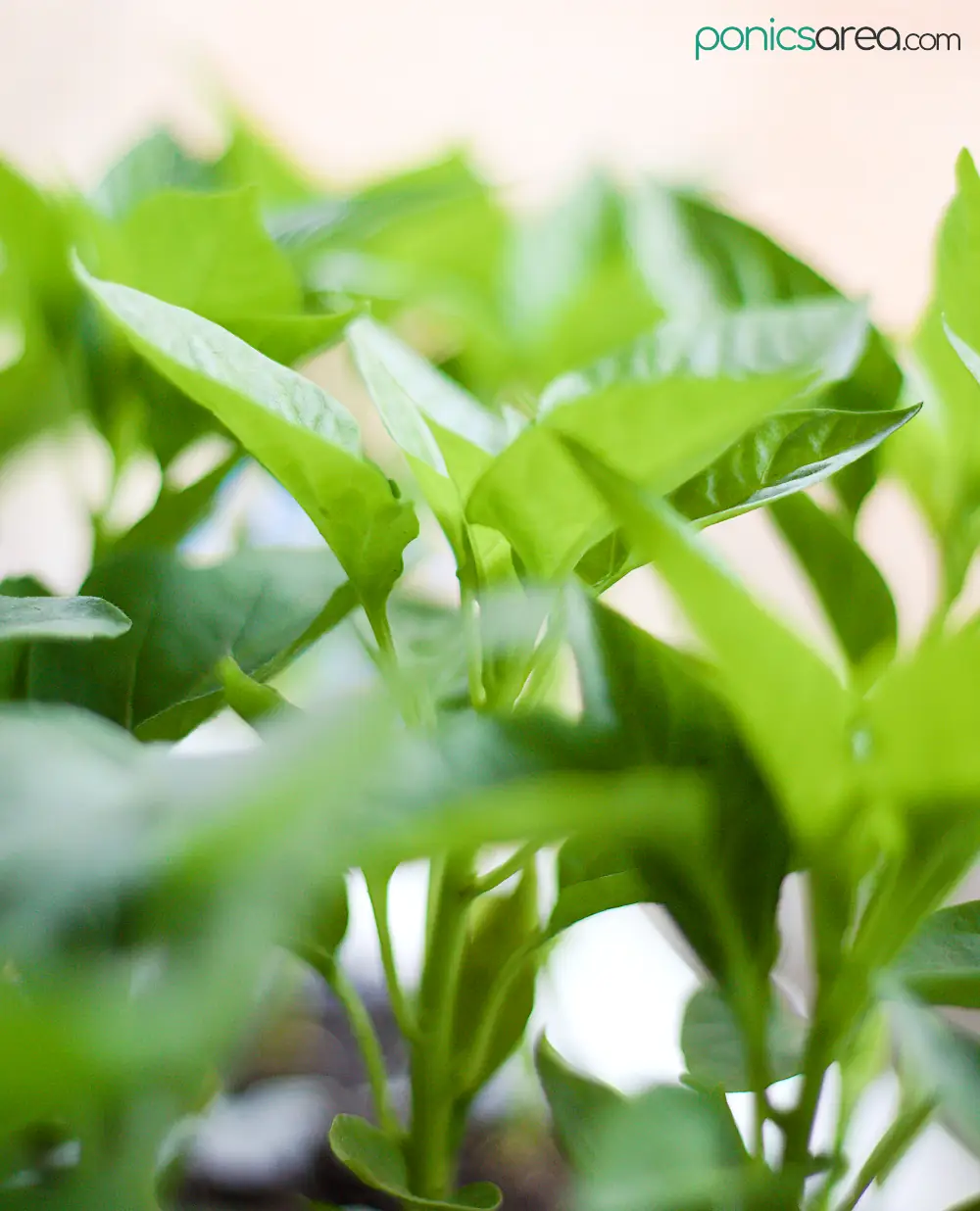
Frankly, I covered most of what you need to know about how to grow peppers in pots when I talked about how to grow them indoors.
A lot of those things apply for outdoor growing, too.
Well, there are a few differences: you don’t need grow lights because you can only grow outdoors when there’s the season for it and you don’t need to pollinate them by hand because there are external factors to take care of all that.
When to grow peppers in pots outdoors
You saw that from sowing the seeds until transplantation, the seedlings need about 6 weeks.
You can transplant them when the danger of cold weather has passed because these plants love their heat.
When daytime temperatures are over 75 degrees Fahrenheit (23-24 degrees C), you can take the pots outdoors.
And that’s about the only additional thing you need to know if you want to grow outdoors. All in all, this is my complete guide on how to grow peppers in pots.

